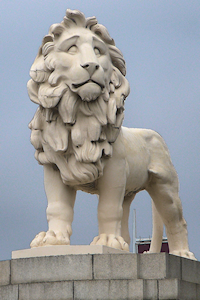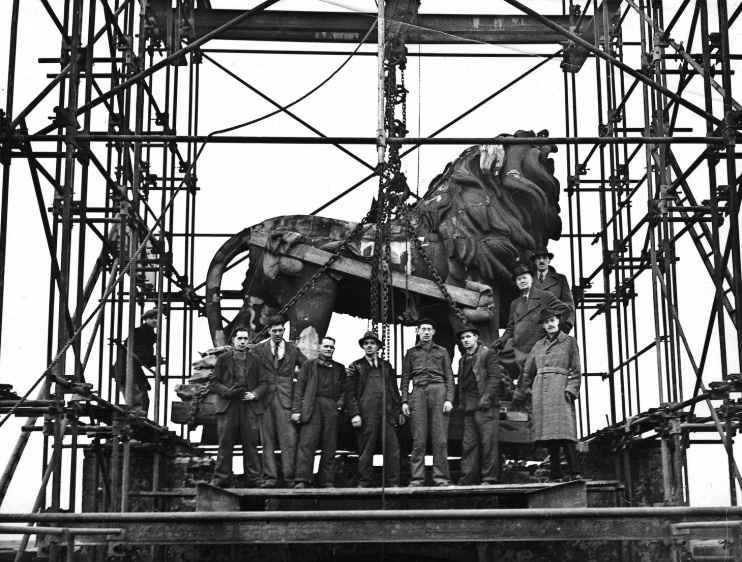South Bank Lion
From brewery mascot to king of the bridge
South Bank Lion, Westminster Bridge, SE1

After the Lambeth marshes were drained at the beginning of the 18th century, this stretch of the South Bank became home to a pleasure garden and then to Lambeth waterworks. At nearby King’s Arm Stairs, in 1769, artificial stone specialist Daniel Pincot joined forces with the experienced entrepreneur Eleanor Coade (whose background was in linen and drapery) to establish a ceramics factory making decorative mouldings. After two years the partners fell out and Mrs Coade thereafter ran the company single-handedly under her own surname.
Her factory specialised in statues, busts and ornamentations for buildings, such as keystone masks, friezes and vases, all made from a material that the proprietress branded Lythodipyra – from the Greek for ‘twice-fired stone’. Most people simply called it Coade stone.
Much admired for its firmness of outline, creamy-white colour and durability, especially its resistance to frost, Coade stone was made from a finely ground mixture of fired clay, flint, sand and glass, baked at a very high temperature for several days.
The business prospered and in 1799 Mrs Coade opened a showroom near Westminster Bridge. She took on a series of business partners, most productively her cousin John Sealy and later a more distant relative, William Croggon, who assumed sole ownership following Mrs Coade’s death in 1821 at her home in Camberwell. She was buried in the Dissenters’ graveyard in Bunhill Fields.
On his own death in 1835, William Croggon was succeeded by his son Thomas John, who kept the company going for a short while before selling out in the face of growing competition from Portland cement. During Thomas John’s period in charge James Goding established the Lion Brewery on a neighbouring plot of land leased from the Archbishop of Canterbury, whose London residence is Lambeth Palace.
Goding commissioned the painter and sculptor William Frederick Woodington to create an emblematic pair of lions for the brewery in 1837. Each was cast in several parts at the Croggon works and then cramped together on an iron frame. They were among the last few items to be made in Coade stone. The beast now known as the South Bank Lion was mounted on a substantial base incised with the single word ‘BREWERY’ and installed on the parapet of the building’s Thames frontage.
The Lion Brewery operated until 1924, when the business was absorbed by Hoare and Company of East Smithfield. The main Lambeth building was seriously damaged by fire in 1931, served as a storehouse for waste paper for a few years and then stood derelict until its demolition in 1949 to make way for the construction of the Royal Festival Hall.
The South Bank Lion was saved – reportedly at the request of George VI – repaired, painted gloss red and mounted on a plinth outside the Waterloo Station gate to the Festival of Britain site. When the station was enlarged in 1966 the lion was relocated to its present prominent position near the Lambeth end of Westminster Bridge, and stripped to the bare stone.
And what of the South Bank Lion’s twin? It too was rescued and now stands atop the central pillar of the west gate at Twickenham Stadium, painted gold.

The photograph above was kindly shared by Nick Redman of London Photos, whose grandfather (second on the left) was one of the scaffolders who helped move the lion from the soon-to-be-demolished brewery.

